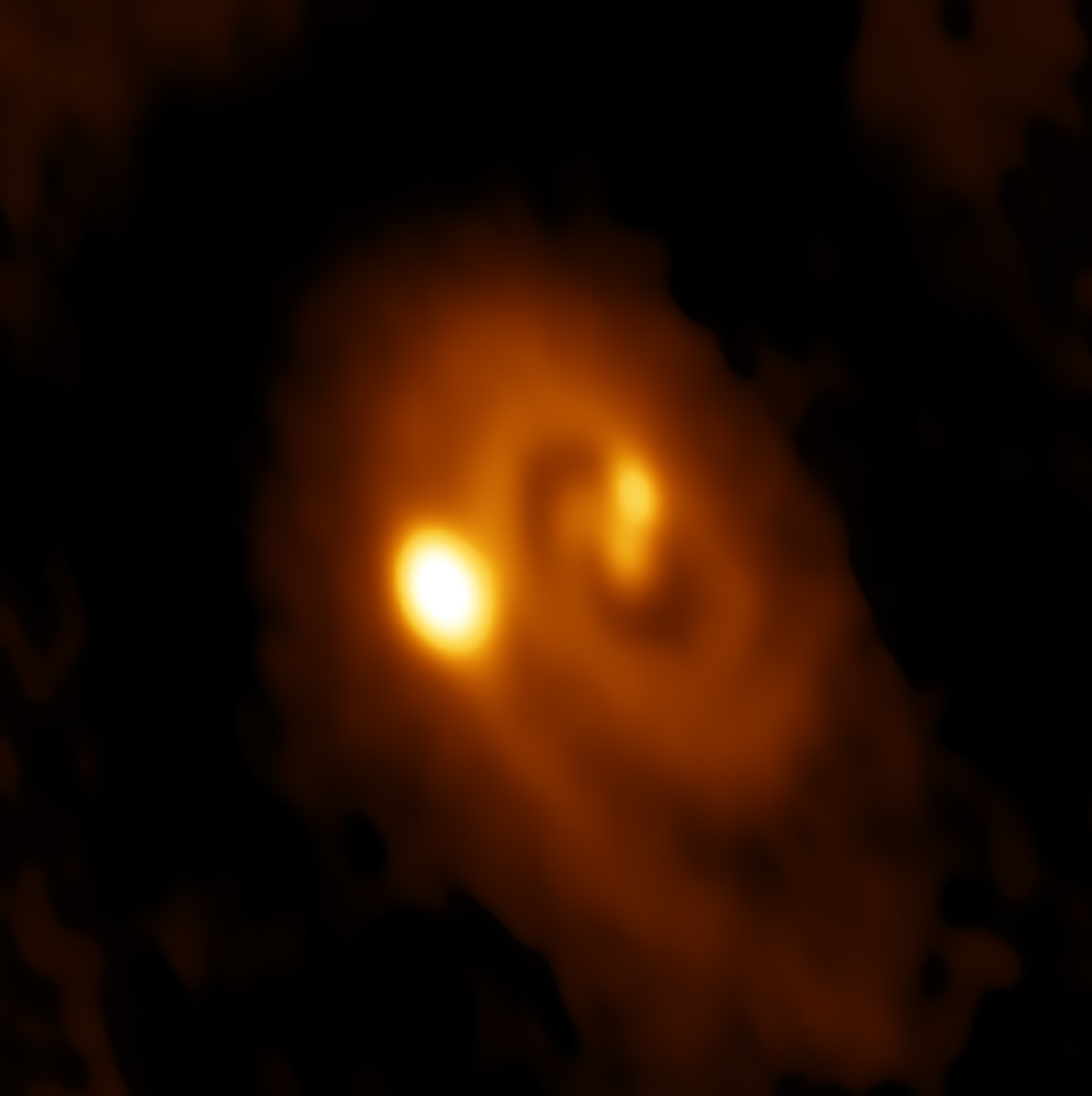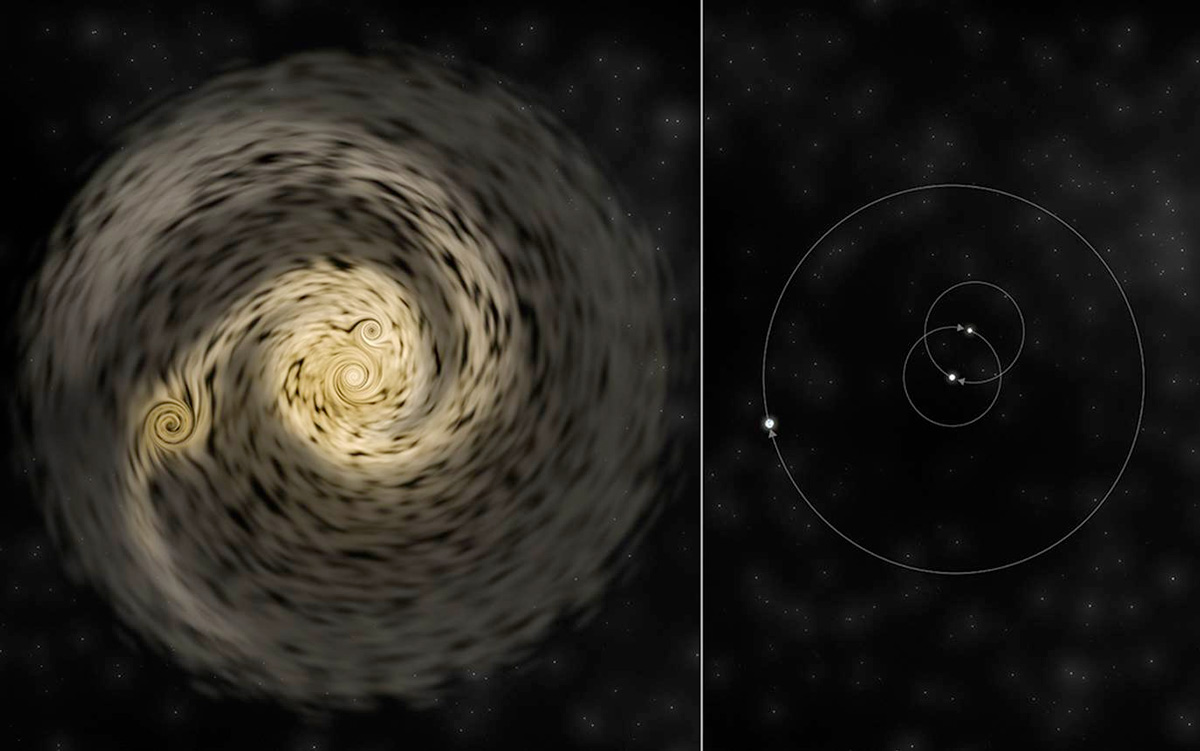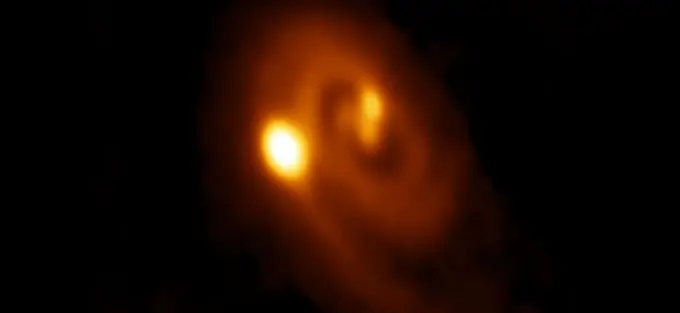Young Stellar System Caught in Act of Forming Close Multiples
26 October, 2016 / Read time: 4 minutes
Scientific Paper ALMA Kids PublicationFor the first time, astronomers have seen a dusty disk of material around a young star fragmenting into a multiple-star system. Scientists had suspected such a process, caused by gravitational instability, was at work, but new observations with the Atacama Large Millimeter/submillimeter Array (ALMA) and the Karl G. Jansky Very Large Array (VLA) revealed the process in action.
"This new work directly supports the conclusion that there are two mechanisms that produce multiple star systems -- fragmentation of circumstellar disks, such as we see here, and fragmentation of the larger cloud of gas and dust from which young stars are formed," said John Tobin, of the University of Oklahoma and Leiden Observatory in the Netherlands.
Stars form in giant clouds of gas and dust, when the tenuous material in the clouds collapses gravitationally into denser cores that begin to draw additional material inward. The infalling material forms a rotating disk around the young star. Eventually, the young star gathers enough mass to create the temperatures and pressures at its center that will trigger thermonuclear reactions.
Previous studies had indicated that multiple star systems tend to have companion stars either relatively close, within about 500 times the Earth-Sun distance, or significantly farther apart, more than 1,000 times that distance. Astronomers concluded that the differences in distance result from different formation mechanisms. The more widely-separated systems, they said, are formed when the larger cloud fragments through turbulence, and recent observations have supported that idea.
The closer systems were thought to result from fragmentation of the smaller disk surrounding a young protostar, but that conclusion was based principally on the relative proximity of the companion stars.

ALMA image of the L1448 IRS3B system, with two young stars at the center and a third distant from them. Spiral structure in the dusty disk surrounding them indicates instability in the disk, astronomers said. Credit: Bill Saxton, ALMA (ESO/NAOJ/NRAO), NRAO/AUI/NSF. | Download image

Combined ALMA and VLA image of L1448 IRS3B system. Credit: Bill Saxton, ALMA (ESO/NAOJ/NRAO), NRAO/AUI/NSF. | Download image
"Now, we've seen this disk fragmentation at work," Tobin said.
Tobin, Kaitlin Kratter of the University of Arizona, and their colleagues used ALMA and the VLA to study a young triple-star system called L1448 IRS3B, located in a cloud of gas in the constellation Perseus, some 750 light-years from Earth. The most central of the young stars is separated from the other two by 61 and 183 times the Earth-Sun distance. All three are surrounded by a disk of material that ALMA revealed to have spiral structure, a feature that, the astronomers said, indicates instability in the disk.
"This whole system probably is less than 150,000 years old." Kratter said. "Our analysis indicates that the disk is unstable, and the most widely separated of the three protostars may have formed only in the past 10,000 to 20,000 years," she added.

Artist's conception of how the triple-star system develops. Left, disk of material fragments into separate protostars. Right, the resulting stellar system. Credit: Bill Saxton, NRAO/AUI/NSF. | Download image
The L1448 IRS3B system, the astronomers conclude, provides direct observational evidence that fragmentation in the disk can produce young multiple-star systems very early in their development.
"We now expect to find other examples of this process and hope to learn just how much it contributes to the population of multiple stars," Tobin said.
The scientists presented their findings in the October 27 edition of the journal Nature.
Additional information
The Atacama Large Millimeter/submillimeter Array (ALMA), an international astronomy facility, is a partnership of the European Organisation for Astronomical Research in the Southern Hemisphere (ESO), the U.S. National Science Foundation (NSF) and the National Institutes of Natural Sciences (NINS) of Japan in cooperation with the Republic of Chile. ALMA is funded by ESO on behalf of its Member States, by NSF in cooperation with the National Research Council of Canada (NRC) and the Ministry of Science and Technology (MOST) in Taiwan and by NINS in cooperation with the Academia Sinica (AS) in Taiwan and the Korea Astronomy and Space Science Institute (KASI).
ALMA construction and operations are led by ESO on behalf of its Member States; by the National Radio Astronomy Observatory (NRAO), managed by Associated Universities, Inc. (AUI), on behalf of North America; and by the National Astronomical Observatory of Japan (NAOJ) on behalf of East Asia. The Joint ALMA Observatory (JAO) provides the unified leadership and management of the construction, commissioning and operation of ALMA.
Contacts
-
Dave Finley
Public Information Officer
Karl G. Jansky Very Large Array (VLA)
Phone: 1 575.835-7302
Email: [email protected]
-
Nicolás Lira
Education and Public Outreach Coordinator
Joint ALMA Observatory, Santiago - Chile
Phone: +56 2 2467 6519
Cel: +56 9 9445 7726
Email: [email protected]
-
Charles E. Blue
Public Information Officer
National Radio Astronomy Observatory Charlottesville, Virginia - USA
Phone: +1 434 296 0314
Cel: +1 202 236 6324
Email: [email protected]
-
Richard Hook
Public Information Officer, ESO
Garching bei München, Germany
Phone: +49 89 3200 6655
Cel: +49 151 1537 3591
Email: [email protected]
-
Masaaki Hiramatsu
Education and Public Outreach Officer, NAOJ Chile
Observatory, Tokyo - Japan
Phone: +81 422 34 3630
Email: [email protected]

